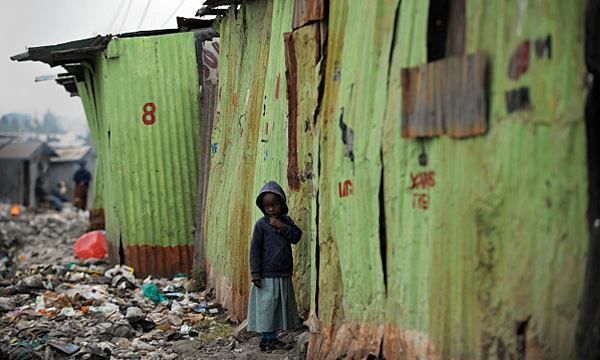
|  |  |  Editorials | Issues Editorials | Issues  
The Save-the-World Clock
 Elizabeth Dickinson - Foreign Policy Elizabeth Dickinson - Foreign Policy
go to original
September 23, 2010


| | (Tony Karumba/AFP/Getty Images) |  |
Global leaders promised a decade ago to end poverty by 2015. With just five years left, the U.N. General Assembly - including an estimated 140 heads of state - will meet this week to assess progress. How much good has been done? Here's a hint: not enough.

Ten years ago, 189 heads of state sat down at the United Nations headquarters in New York and drafted an impressively ambitious set of anti-poverty goals - to cut destitution in half, to reduce hunger, to boost school enrollment, and to make the world a more equal, just place. They called their eight targets the Millennium Development Goals, with an aim to "free our fellow men, women and children from the abject and dehumanizing conditions of extreme poverty, to which more than a billion of them are currently subjected." All this was to be accomplished by 2015.

Now, with only five years left until the deadline, country leaders are gathering in New York for a 2010 review summit to determine what can still be done to meet it.

In some ways, the so-called MDGs have already made history. Their adoption marked the first time that the entire world agreed that the poor -- the least politically empowered group of people on earth - would suddenly become a priority. The goals were refreshingly specific, for example calling for a reduction in the deaths of children under five by two-thirds. Humanity could be proud of the promises made.

Yet a decade on, it's clear the world has too often, and in too many cases, fallen behind. There has been progress: School enrollment for example, has skyrocketed even in the poorest countries, and the world will likely meet its goal to halve poverty overall. But while countries such as Ghana and Rwanda have made strides, many others are showing little improvement. For instance, U.N. Secretary-General Ban Ki-moon's pre-summit report notes that without China, progress on overall poverty rates "does not look very encouraging. In fact, the number of people living in extreme poverty actually went up between 1990 and 2005." Gender equality and women's rights have shown the least improvement since 2000. Inequality has remained stubbornly high; children from the poorest households worldwide, for example, are twice as likely to die as their wealthy peers.

So, did the world bite off more than it could chew? Yes, mostly likely we did - though that was kind of the point. Peter Yeo, the executive director of the Better World Campaign, an advocacy group supporting U.N. anti-poverty efforts, told me that what the goals have done is create political momentum for the fight on poverty - they are the beginning of a journey, not the end. And as to how the world will keep pursing them after 2015, "That discussion has already begun."

The most important question now, experts say, is not whether the world can meet these goals, but how and where we won't - in other words, what we need to do better from here on. Here's a quick look at each of the goals, the progress made, and why there's still far more work to be done.

In the last half-century that the world has been trying to do "development," perhaps the biggest lesson that analysts and aid workers have learned is that cutting poverty is pretty much an all-or-nothing proposition: You can't, for instance, improve education if you don't empower women; you can't feed people if you don't shore up the international trading regime; and you can't reduce inequality when corruption pervades.

With this in mind, the MDGs were designed to be broad, including everything from children to women to agriculture to health. But they also point to specific, quantifiable goals that policymakers could work toward, and be held accountable for, if progress stalls.

|

 |
|  |



